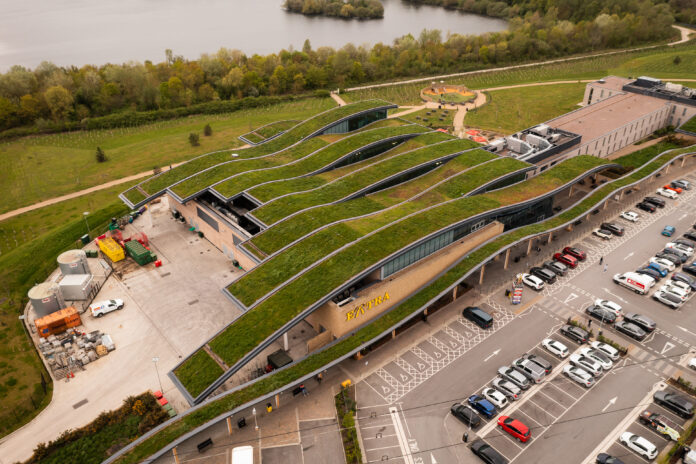
With an ever-increasing global concern for climate change and resource depletion, the commercial sector is making significant strides toward creating more energy-efficient and environmentally friendly structures. Let’s explore the concept of net-zero energy buildings, their importance, and the innovative techniques that are driving this transformation within the commercial construction sector.
Understanding Net-Zero Energy Buildings
A net-zero energy building is a structure designed and constructed to produce as much energy as it consumes over the course of a year. Achieving this balance typically involves a combination of energy-efficient design, on-site renewable energy generation, and energy storage solutions. The goal is to minimize the building’s carbon footprint and dependency on traditional energy sources.
The Significance of Net-Zero Energy Buildings
Net-zero energy buildings offer several benefits to both the environment and building owners. These include:
Environmental Sustainability
Net-zero energy buildings significantly reduce greenhouse gas emissions and reliance on fossil fuels. This leads to a notable decrease in the building’s environmental impact.
Cost Savings
By producing their energy, these buildings can experience a reduction in utility costs, eventually leading to cost savings for building owners and tenants.
Enhanced Reputation
Net-zero energy buildings are seen as exemplars of sustainable practices, enhancing the reputation of businesses or organizations that choose to invest in such structures.
Regulatory Compliance
Many regions are implementing stricter energy efficiency and sustainability standards. Net-zero energy buildings help ensure compliance with these regulations.
9 Innovative Techniques for Net-Zero Energy Building Design
1. Energy-Efficient Building Envelopes
The foundation of net-zero energy building design lies in creating a robust and energy-efficient building envelope. This envelope acts as the building’s protective shell, and it’s essential to ensure minimal energy loss. It incorporates several key elements, including high-performance insulation materials, advanced window systems with low U-values, and reduced air leakage through quality seals and construction techniques. These components work together to create a well-insulated and airtight structure, significantly reducing the need for heating or cooling.
2. Renewable Energy Generation
Net-zero energy buildings make use of renewable energy sources to produce electricity on-site. Solar panels, photovoltaic arrays, wind turbines, and geothermal systems are popular choices. Solar panels, for instance, capture energy from the sun and convert it into electricity, reducing reliance on traditional grid power. Wind turbines harness wind energy, while geothermal systems tap into the Earth’s natural heat. The electricity generated can power the building’s systems and even be stored for later use.
3. Advanced HVAC Systems
High-efficiency heating, ventilation, and air conditioning (HVAC) systems are integral to net-zero energy building design. These systems are designed to be energy-efficient, using advanced technologies like variable-speed compressors, heat recovery ventilation, and zone-based controls. They not only maintain comfortable indoor temperatures but also minimize energy consumption by optimizing heating and cooling loads.
4. Energy Storage Solutions
Continuous power supply is crucial for net-zero energy buildings, especially when renewable energy sources are intermittent. Energy storage solutions, such as lithium-ion batteries, play a vital role. They store excess energy generated during periods of high production, such as sunny days, and release it during peak demand or when renewable sources are unavailable. This ensures a consistent and reliable power supply while reducing the reliance on the grid.
5. Smart Building Technology
Smart building technology integrates sensors, energy management systems, and real-time data analysis to monitor and control energy usage with precision. These systems allow for the optimization of lighting, HVAC, and other building systems based on occupancy, external conditions, and energy demand. They ensure that energy is used efficiently and not wasted when it’s not needed.
6. Daylighting and Passive Design
Effective use of natural daylight and passive design principles are fundamental to reducing energy consumption in net-zero energy buildings. Designers maximize the use of natural light by strategically positioning windows and employing daylight harvesting systems. Passive design includes features like proper orientation, shading, and thermal mass to regulate indoor temperatures naturally. This not only reduces the need for artificial lighting and heating but also enhances occupant comfort.
7. Green Roof and Wall Systems
Green roof and wall systems introduce vegetation into the building’s design, providing natural insulation and improving energy efficiency. They act as an additional layer of insulation, reducing heat gain in summer and heat loss in winter. Green roofs also mitigate the urban heat island effect, enhance air quality, and contribute to overall sustainability.
8. Heat Recovery Systems
Heat recovery systems capture and reuse heat generated within the building. For example, in a ventilation system, heat exchangers can recover warmth from outgoing air and transfer it to incoming fresh air. This process significantly reduces the energy required to heat or cool the building, leading to energy savings.
9. Behavioral Analysis
Encouraging energy-efficient behaviors among building occupants is a crucial aspect of net-zero energy building design. This can be achieved through awareness and engagement campaigns. Occupants can be educated about the building’s sustainable features and provided with guidelines on reducing energy consumption, such as turning off lights when not in use or using natural ventilation when conditions allow.
Case Studies in Net-Zero Energy Commercial Buildings
To provide practical insights, let’s explore some inspiring examples of net-zero energy commercial buildings:
1. The Edge, Amsterdam
The Edge, located in Amsterdam, is celebrated as one of the greenest and most sustainable commercial buildings globally. Its design prioritizes energy efficiency and sustainability. The building’s remarkable features include an extensive array of solar panels covering its south-facing facade, producing a substantial portion of its electricity needs. Additionally, rainwater harvesting systems are employed to minimize water consumption. One of its standout attributes is the advanced Internet of Things (IoT) technology that optimizes energy use, lighting, and climate control based on real-time data and occupancy. This smart building technology not only enhances energy efficiency but also provides an exceptional work environment for occupants.
2. Phipps Conservatory and Botanical Gardens, Pittsburgh
The Phipps Conservatory and Botanical Gardens in Pittsburgh is a remarkable example of a net-zero energy building that harmonizes with nature. This facility achieves net-zero energy consumption by employing a combination of renewable energy sources. Geothermal systems tap into the Earth’s stable temperatures to provide heating and cooling. Solar panels capture energy from the sun, while wind turbines harness the power of the wind to generate electricity. The holistic approach to sustainability at Phipps extends beyond energy to include water conservation, sustainable landscaping, and an emphasis on education and public engagement in eco-friendly practices.
3. Bullitt Center, Seattle
The Bullitt Center, situated in Seattle, is an ambitious project that redefines the concept of sustainable commercial construction. Its net-zero energy design incorporates an extensive photovoltaic panel array on the roof to generate electricity from sunlight. The building’s unique features include composting toilets, which reduce water consumption and contribute to waste reduction. Natural ventilation systems provide efficient cooling and ventilation while reducing the need for energy-intensive HVAC. The Bullitt Center has set a high bar for sustainable building design and construction, showcasing that a net-zero energy commercial building can be both environmentally friendly and a comfortable, modern workspace.
The Future of Net-Zero Energy Buildings
As the importance of environmental sustainability continues to grow, net-zero energy building design is expected to become the standard in the commercial sector. The integration of innovative techniques, renewable energy sources, and smart technologies will drive the development of more energy-efficient and eco-friendly commercial structures. These advancements will not only benefit the environment but also provide long-term cost savings for building owners while aligning with evolving regulatory requirements.
The commercial sector is undergoing a transformative shift towards net-zero energy building design. This shift not only addresses environmental concerns but also demonstrates that sustainability and profitability can coexist. As new technologies and innovative techniques continue to emerge, net-zero energy commercial buildings are poised to become the cornerstone of a more sustainable and eco-conscious future.




